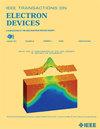Design Optimizations of Micrometer SiC CMOS Devices for High-Temperature IC Applications
IF 3.2
2区 工程技术
Q2 ENGINEERING, ELECTRICAL & ELECTRONIC
引用次数: 0
Abstract
This article proposes the generalized design guideline for micrometer silicon carbide (SiC) complementary metal-oxide-semiconductor (CMOS) devices for integrated circuit (IC) applications. The design window of 1-用于高温IC应用的微米SiC CMOS器件的设计优化
本文提出了用于集成电路(IC)应用的微米级碳化硅(SiC)互补金属氧化物半导体(CMOS)器件的通用设计准则。提出了考虑器件工作电压、导通电流、短沟道效应(SCE)和亚阈值摆幅(SS)的1- $\mu $ m SiC CMOS器件的设计窗口,以显示栅极氧化物厚度和沟道掺杂浓度的设计裕度。用1- $\mu $ m SiC CMOS工艺中CMOS器件的性能来证明所提出的设计窗口的有效性。测试了基于sic的缓冲链电路,以演示电路的运行速度和功耗。器件和电路在25°C至300°C范围内进行了充分表征。由于SiC CMOS器件具有强SCE,高SS和低状态电流,因此在大规模实施之前需要进一步改进设计。另一方面,与Si ic相比,SiC ic随着温度的升高而表现出更少的降解,这使得它们在高温应用中具有前景。
本文章由计算机程序翻译,如有差异,请以英文原文为准。
求助全文
约1分钟内获得全文
求助全文
来源期刊

IEEE Transactions on Electron Devices
工程技术-工程:电子与电气
CiteScore
5.80
自引率
16.10%
发文量
937
审稿时长
3.8 months
期刊介绍:
IEEE Transactions on Electron Devices publishes original and significant contributions relating to the theory, modeling, design, performance and reliability of electron and ion integrated circuit devices and interconnects, involving insulators, metals, organic materials, micro-plasmas, semiconductors, quantum-effect structures, vacuum devices, and emerging materials with applications in bioelectronics, biomedical electronics, computation, communications, displays, microelectromechanics, imaging, micro-actuators, nanoelectronics, optoelectronics, photovoltaics, power ICs and micro-sensors. Tutorial and review papers on these subjects are also published and occasional special issues appear to present a collection of papers which treat particular areas in more depth and breadth.
 求助内容:
求助内容: 应助结果提醒方式:
应助结果提醒方式:


